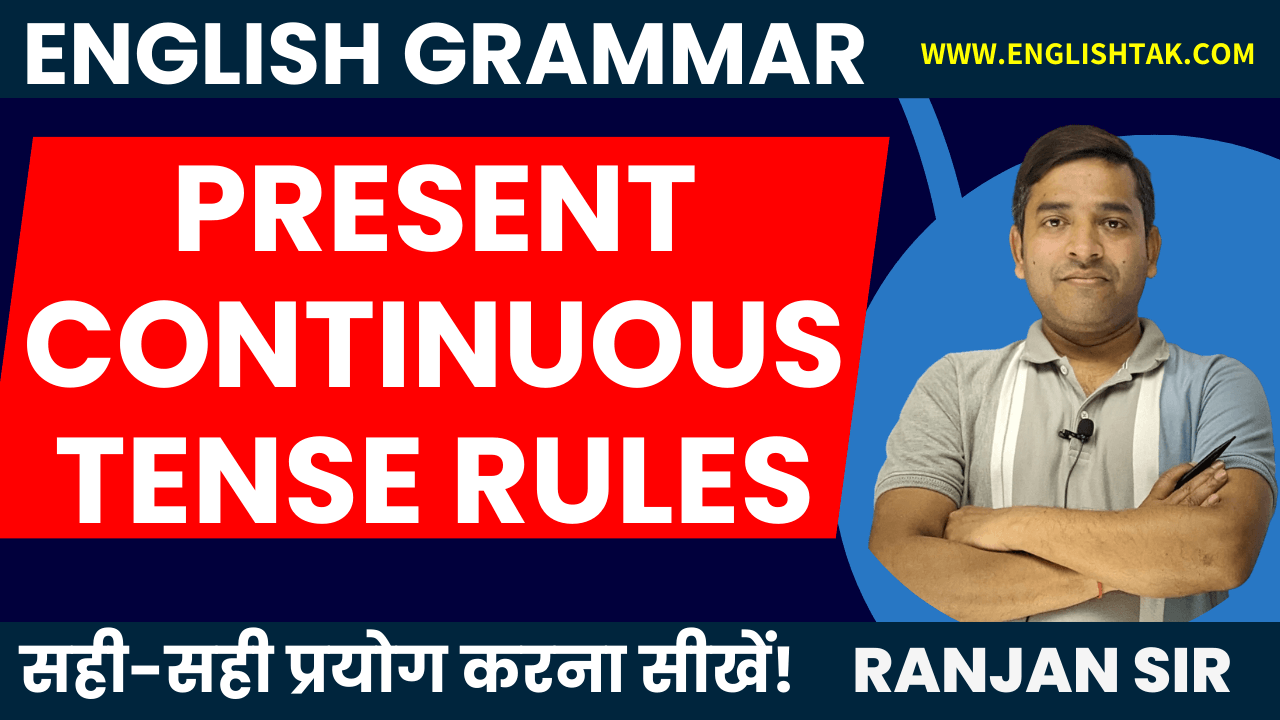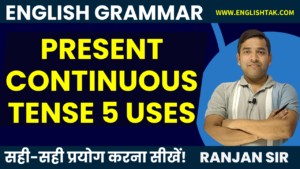![]()
Present Continuous Tense Rules in Hindi
Present Continuous Tense Rules in Hindi – Present Continuous Tense से हमें किसी ऐसे कार्य या घटना के वर्तमान में जारी होने का पता चलता है, जो हमारी आंखों के सामने हो रहा हो। Present Continuous Tense में किसी कार्य या घटना का अपूर्ण होना पाया जाता है। इस टेंस को Present Progressive Tense के नाम से भी जाना जाता है। जैसे – सीमा चित्र बना रही है। (Seema is drawing a picture.) अजय नाश्ता कर रहा है। (Ajay is having breakfast.)
The Present Continuous Tense indicates that an action or event is currently ongoing, happening in front of our eyes. In the Present Continuous Tense, an action or event is considered incomplete. This tense is also known as the Present Progressive Tense. For example – Seema is drawing a picture. (Seema is drawing a picture.) Ajay is having breakfast. (Ajay is having breakfast.)
हिंदी में Continuous का अर्थ जारी होना या बिना रुके निरंतर होना होता है। इस Tense में कर्ता द्वारा कोई कार्य किया जाता है और बोलने के समय वह कार्य हमारी आंखों के सामने हो रहा होता है। उसी कार्य को इस Tense में अपूर्ण माना जाता है, अतः इस टेंस का अर्थ हिंदी में अपूर्ण वर्तमान काल होता है।
Present Continuous Tense Rules in Hindi
In Hindi, the meaning of “Continuous” is to continue or to be uninterrupted. In this tense, an action is performed by the subject, and at the time of speaking, that action is happening in front of our eyes. This action is considered incomplete in this tense; therefore, this tense is understood in Hindi as the “Present Imperfect Tense.”
Present Continuous Tense की पहचान
हिंदी वाक्यों की क्रियाओं के अंत में रहा है, रही है, रहे हैं, रहा हूं, हुआ है आदि आते हैं। किसी कार्य का लगातार जारी होना पाया जाता है। इस Present Continuous Tense को हिंदी में वर्तमान अपूर्ण काल कहते हैं। जैसे;
In Hindi sentences, the verbs often end with “Raha hai,” “Rahi hai,” “Rahe hai,” “Raha hu,” “Hua hai,” etc. This indicates that an action is continuously ongoing. This Present Continuous Tense is referred to as the “imperfect present tense” in Hindi. For example:
1. मैं पढ़ाई कर रहा हूं। (I am studying.)
2. हम टेनिस खेल रहे हैं। (We are playing tennis.)
3. तुम फिल्म देख रहे हो। (You are watching a movie.)
4. वे सब्जियां खरीद रहे हैं। (They are buying vegetables.)
5. वह कागज पर लिख रही है। (She is writing on paper.)
6. राधिका किताब पढ़ रही है। (Radhika is reading a book.)
7. गिलास में पानी भर रहा है। (He is filling water in the glass.)
8. लड़के खेल रहे हैं। (The boys are playing.)
9. बच्चा सो रहा है। (The child is sleeping.)
10. लोग पार्क में टहल रहे हैं। (People are walking in the park.)
उपरोक्त वाक्यों में क्रियाओं के अंत में रहा है, रही है, रहे हैं, रहा हूं आदि शब्द जुड़े हुए हैं। अतः इनसे स्पष्ट होता है कि ये वाक्य Present Continuous Tense के हैं। अगर आप सबसे आखिरी वाले वाक्य को देखेंगे तो उसमें किसी व्यक्ति के कहीं जाने की बात कही जा रही है; वह कल कहीं जा रहा है। इससे यह ज्ञात होता है कि इस वाक्य में घटना अभी हमारी आंखों के सामने नहीं घट रही है। यह आने वाले भविष्य में घटेगी, अर्थात यह Tense Future Reference के लिए भी प्रयोग किया जाता है। Present Continuous Tense Examples in Hindi से संबंधित सभी वाक्यों के स्ट्रक्चर को आगे दिया गया है।
In the above sentences, the verbs end with words like “Raha hai,” “Rahi hai,” “Rahe hai,” “Raha hu,” “Hua hai,” etc. This clearly indicates that these sentences are in the Present Continuous Tense. If you look at the last sentence, it talks about someone going somewhere; “He is going somewhere tomorrow.” This indicates that the event is not happening in front of our eyes right now. It will occur in the near future, meaning this tense is also used for future reference. The structure of all the sentences related to Present Continuous Tense examples in Hindi is provided below.
मुख्य क्रिया (Main Verb)
Present Continuous Tense की मुख्य क्रिया की I Form का प्रयोग करते हैं। इसके साथ ing भी जोड़ते हैं। जैसे;
The main verb in the Present Continuous Tense is used in its I Form, and “ing” is also added to it.
– Go – going
– Eat – eating
– Drive – driving
– Fly – flying
Main verb में ing जोड़ने के नियम
1. यदि किसी Verb के अंत में कोई व्यंजन (consonant) आए और उससे पहले कोई Vowel आये, तो आखिरी Letter को Double करके उसमें ing जोड़ते हैं। जैसे;
Dig + ing → Digging
Cut + ing → Cutting
Hit + ing → Hitting
Begin + ing → Beginning
Put + ing → Putting
Set + ing → Setting
2. यदि किसी Verb के अंत में ‘ie’ जुड़ा हो, तो ie की जगह y लगाकर ing जोड़ देते हैं। जैसे;
Lie + ing → Lying
Vie + ing → Vying
Tie + ing → Tying
Die + ing → Dying
3. जिन Verbs के अंतिम Letter ‘e’ हो, तो e को हटाकर ing जोड़ा जाता है। जैसे;
Drive + ing = Driving
Leave + ing = Leaving
Write + ing = Writing
Save + ing = Saving
Live + ing = Living
Dive + ing = Diving
4. यदि verb के अंत में ee आए, तो उसमें e नहीं हटाते हैं और उसमें ing जोड़ देते हैं।
See → Seeing
Agree → Agreeing
Flee → Fleeing
Disagree → Disagreeing
5. Irregular Verbs: Some verbs have unique forms, but generally, they still follow the basic rules for adding “ing.”
be → being
lie → lying.
सहायक क्रिया (Helping Verb)
इस टेंस की सहायक क्रिया (Helping Verb) is, am, are होती है।
1. Singular Subjects (Singular Nouns या Pronouns) के साथ is का प्रयोग करते हैं।
– वह दौड़ रहा है। (He is running.)
– वह रो रही है। (She is weeping.)
– बारिश हो रही है। (It is raining.)
– राम जा रहा है। (Ramu is going.)
– गाय घास खा रही है। (The cow is grazing.)
– लड़का तैर रहा है। (The boy is swimming.)
– लड़की नृत्य कर रही है। (The girl is dancing.)
2. Plural Subjects (Plural Nouns या Pronouns) के साथ are का प्रयोग करते हैं।
– तुम इंतज़ार कर रहे हो। (You are waiting.)
– हम खेल रहे हैं। (We are playing.)
– वे आ रहे हैं। (They are coming.)
– लड़के सफाई कर रहे हैं। (The boys are cleaning.)
– लड़कियां गा रही हैं। (The girls are singing.)
– बच्चे पढ़ाई कर रहे हैं। (The boys are reading.)
– वे कुत्ते भौंक रहे हैं। (Those dogs are barking.)
3. Am का प्रयोग I के साथ किया जाता है।
– मैं पढ़ाई कर रहा हूं। (I am studying.)
– मैं चल रहा हूं। (I am walking.)
ऊपर दिए गए sentences में singular subjects (एकवचन कर्ता) के साथ is का प्रयोग किया गया है तथा Plural Subjects (बहुवचन कर्ता) के साथ are का प्रयोग किया गया है तथा I के साथ am का प्रयोग किया गया है।
Affirmative Sentences (साधारण वाक्य)
Affirmative sentence बनाने के लिए नीचे sentence structure दिया गया है। इसके अनुसार नीचे दिए गए steps को follow करते हैं।
1. हम subject को सबसे पहले रखते हैं।
2. उसके बाद कर्ता के अनुसार is, am या are का प्रयोग किया जाता है।
3. Helping Verb रखने के बाद हम मुख्य क्रिया की First form में ing जोड़कर रखते हैं।
4. अंत में verb के बाद object को रखते हैंं।
5. यदि वाक्य में कोई अन्य शब्द तो उन्हें वाक्य के अंत में रखते हैं।
Structure: Subject + is/am/are + V1 + ing + object + other words
Examples:
1. वह गाना गा रही है। (She is singing a song.)
2. वह कहानी सुनाता है। (He is telling a story.)
3. आज बारिश हो रही है। (It is raining today.)
4. लड़का अपने कमरे में पढ़ रहा है। (The boy is studying in his room.)
5. गाय घास खा रही है। (The cow is eating the grass.)
6. वे मैदान में फुटबॉल खेल रहे हैं। (They are playing football in the field.)
7. तुम गणित के प्रश्न हल कर रहे हो। (You are solving the math problems.)
8. मैं उसकी मदद कर रहा हूं। (I am helping him.)
9. मेरे दादा जी इस समय रामायण पढ़ रहे हैं। (My grandfather is reading the Ramayana now.)
10. ये लड़के शोर कर रहे हैं। (These boys are making noise.)
11. तुम्हारे दादा जी छाता खरीद रहे हैं। (Your grandfather is buying an umbrella.)
12. वह पानी ला रहा है। (He is bringing water.)
13. वैज्ञानिक कोरोनावायरस की वैक्सीन खोज रहे हैं। (Scientists are searching for the coronavirus vaccine.)
14. लोग इस जंगल से होकर जा रहे हैं। (People are passing through this forest.)
15. कोई दरवाजा खटखटा रहा है। (Someone is knocking at the door.)
16. आज वह अपने गांव जा रहा है। (He is going to his village today.)
17. श्याम अपनी गलती स्वीकार कर रहा है। (Shyam is accepting his mistake.)
18. तुम्हारा भाई नई कंपनी की स्थापना कर रहा है। (Your brother is establishing a new company.)
19. पिताजी मंदिर में पूजा कर रहे हैं। (Father is worshipping in the temple.)
20. सोहन नई तस्वीर खींच रहा है। (Sohan is taking a new picture.)
Present Continuous Tense Rules in Hindi
Negative Sentences (नकारात्मक वाक्य)
Negative sentences बनाने के लिए नीचे sentence structure दिया गया है। इसके अनुसार नीचे दिए गए steps को follow करते हैं।
1. हम subject को सबसे पहले रखते हैं।
2. उसके बाद कर्ता के अनुसार is, am या are का प्रयोग किया जाता है।
3. Helping verb के बाद not जोड़ते हैं।
4. इसके बाद मुख्य क्रिया की First form में ing जोड़कर रखते हैं।
5. अंत में verb के बाद object को रखते हैं।
6. यदि वाक्य में कोई अन्य शब्द तो उन्हें वाक्य के अंत में रखते हैं।
Structure: Subject + is/am/are + not + V1 + ing + object + other words
Examples:
1. वह गाना नहीं गा रही है। (She is not singing a song.)
2. वह कहानी नहीं सुनाता है। (He is not telling a story.)
3. आज बारिश नहीं हो रही है। (It is not raining today.)
4. लड़का अपने कमरे में नहीं पढ़ रहा है। (The boy is not studying in his room.)
5. गाय घास नहीं खा रही है। (The cow is not eating the grass.)
6. वे मैदान में फुटबॉल नहीं खेल रहे हैं। (They are not playing football in the field.)
7. तुम गणित के प्रश्न हल नहीं कर रहे हो। (You are not solving the math problems.)
8. मैं उसकी मदद नहीं कर रहा हूं। (I am not helping him.)
9. मेरे दादा जी इस समय रामायण नहीं पढ़ रहे हैं। (My grandfather is not reading the Ramayana now.)
10. ये लड़के शोर नहीं कर रहे हैं। (These boys are not making noise.)
11. तुम्हारे दादा जी छाता नहीं खरीद रहे हैं। (Your grandfather is not buying an umbrella.)
12. वह पानी नहीं ला रहा है। (He is not bringing water.)
13. वैज्ञानिक कोरोनावायरस की वैक्सीन नहीं खोज रहे हैं। (Scientists are not searching for the coronavirus vaccine.)
14. लोग इस जंगल से होकर नहीं जा रहे हैं। (People are not passing through this forest.)
15. कोई दरवाजा नहीं खटखटा रहा है। (Someone is not knocking at the door.)
16. आज वह अपने गांव नहीं जा रहा है। (He is not going to his village today.)
17. श्याम अपनी गलती स्वीकार नहीं कर रहा है। (Shyam is not accepting his mistake.)
18. तुम्हारा भाई नई कंपनी की स्थापना नहीं कर रहा है। (Your brother is not establishing a new company.)
19. पिताजी मंदिर में पूजा नहीं कर रहे हैं। (Father is not worshipping in the temple.)
20. सोहन नई तस्वीर नहीं खींच रहा है। (Sohan is not taking a new picture.)
Present Continuous Tense Rules in Hindi
Interrogative Sentences (प्रश्नवाचक वाक्य)
Interrogative sentences बनाने के लिए नीचे sentence structure दिया गया है। इसके अनुसार नीचे दिए गए steps को follow करते हैं।
1. Is, am, are का प्रयोग सबसे पहले करते हैं।
2. उसके बाद subject का प्रयोग करते हैं।
3. Helping verb के बाद मुख्य क्रिया की First form में ing जोड़कर रखते हैं।
4. अंत में verb के बाद object को रखते हैं।
5. यदि वाक्य में कोई अन्य शब्द तो उन्हें वाक्य के अंत में रखते हैं।
Structure: Is/am/are + subject + V1 + ing + object + other words + ?
Examples:
1. क्या वह गाना गा रही है? (Is she singing a song?)
2. क्या वह कहानी सुनाता है? (Is he telling a story?)
3. क्या आज बारिश हो रही है? (Is it raining today?)
4. क्या लड़का अपने कमरे में पढ़ रहा है? (Is the boy studying in his room?)
5. क्या गाय घास खा रही है? (Is the cow eating the grass?)
6. क्या वे मैदान में फुटबॉल खेल रहे हैं? (Are they playing football in the field?)
7. क्या तुम गणित के प्रश्न हल कर रहे हो? (Are you solving the math problems?)
8. क्या मैं उसकी मदद कर रहा हूं? (Am I helping him?)
9. क्या मेरे दादा जी इस समय रामायण पढ़ रहे हैं? (Is my grandfather reading the Ramayana now?)
10. क्या ये लड़के शोर कर रहे हैं? (Are these boys making noise?)
11. क्या तुम्हारे दादा जी छाता खरीद रहे हैं? (Is your grandfather buying an umbrella?)
12. क्या वह पानी ला रहा है? (Is he bringing water?)
13. क्या वैज्ञानिक कोरोनावायरस की वैक्सीन खोज रहे हैं? (Are scientists searching for the coronavirus vaccine?)
14. क्या लोग इस जंगल से होकर जा रहे हैं? (Are people passing through this forest?)
15. क्या कोई दरवाजा खटखटा रहा है? (Is someone knocking at the door?)
16. क्या आज वह अपने गांव जा रहा है? (Is he going to his village today?)
17. क्या श्याम अपनी गलती स्वीकार कर रहा है? (Is Shyam accepting his mistake?)
18. क्या तुम्हारा भाई नई कंपनी की स्थापना कर रहा है? (Is your brother establishing a new company?)
19. क्या पिताजी मंदिर में पूजा कर रहे हैं? (Is father worshipping in the temple?)
20. क्या सोहन नई तस्वीर खींच रहा है? (Is Sohan taking a new picture?)
Present Continuous Tense Rules in Hindi
Interrogative Negative Sentences of Present Continuous Tense
जो वाक्य क्या से शुरू होते हैं और जिनमें नहीं शब्द आता है, या जिन वाक्यों में कोई प्रश्नवाचक शब्द शामिल होता है, ऐसे वाक्य Present Continuous Tense के Interrogative Negative Sentences कहलाते हैं।
इन्हें बनाने के लिए हमें subject के बाद not का इस्तेमाल करना होता है, और बाकी परिवर्तन वही नियमों के अनुसार किए जाते हैं।
Yes-No Type Negative Questions (क्या वाले नकारात्मक वाक्य)
Examples:
1. क्या तुम उसकी मदद नहीं कर रहे हो?
Are you not helping him?
2. क्या वह आज किताब नहीं पढ़ रहा है?
Is he not reading a book today?
3. क्या तुम क्रिकेट नहीं खेल रहे हो?
Are you not playing cricket?
4. क्या वे पार्क में नहीं खेल रहे हैं?
Are they not playing in the park?
5. क्या तुम अपना काम नहीं कर रहे हो?
Are you not doing your work?
6. क्या वह खाना नहीं बना रहा है?
Is he not cooking food?
7. क्या बच्चा रो नहीं रहा है?
Is the child not crying?
8. क्या भारत के प्रधानमंत्री जी भाषण नहीं दे रहे हैं?
Isn’t the Prime Minister of India giving a speech?
9. क्या तुम इस आदमी से बात नहीं कर रहे हो?
Aren’t you talking to this man?
10. क्या वह शहर से वापस नहीं आ रहा है?
Is he not returning from the city?
Present Continuous Tense Rules in Hindi
Wh-word Type Negative Questions (प्रश्नवाचक शब्द वाले नकारात्मक वाक्य)
Examples:
1. क्यों वे अपनी किताब नहीं पढ़ रहे हैं?
Why are they not reading their book?
2. अब बारिश क्यों नहीं हो रही है?
Why is it not raining now?
3. कौन तुम्हारी मदद नहीं कर रहा है?
Who is not helping you?
4. वे क्यों नहीं बाहर जा रहे हैं?
Why are they not going outside?
5. तुम्हारी समस्या का समाधान कौन नहीं कर रहा है?
Who is not solving your problem?
6. वह आज स्कूल क्यों नहीं जा रहा है?
Why is he not going to school today?
7. तुम्हारे दादा जी क्यों नहीं चल रहे हैं?
Why is your grandfather not walking?
8. वह कौन सी फिल्म नहीं देख रहा है?
Which movie is he not watching?
9. तुम उसे अंदर क्यों नहीं आने दे रहे हो?
Why are you not letting him in?
10. इस कंपनी का मालिक हमारा वेतन क्यों नहीं दे रहा है?
Why is the owner of this company not paying our salary?
Uses of Present Continuous Tense in Hindi
English Grammar Course in Hindi
Tense in English Grammar in Hindi
What is Tense in English Grammar with Hindi





